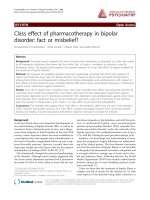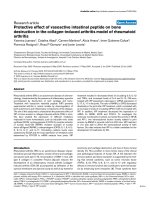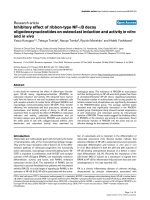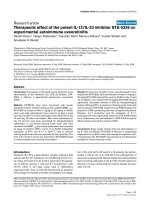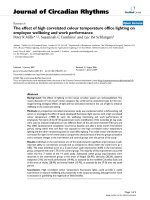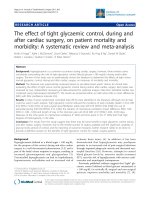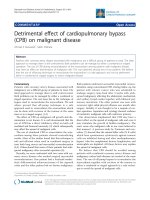Báo cáo y học: "Antimelanogenic effect of c-phycocyanin through modulation of tyrosinase expression by upregulation of ERK and downregulation of p38 MAPK signaling pathway" docx
Bạn đang xem bản rút gọn của tài liệu. Xem và tải ngay bản đầy đủ của tài liệu tại đây (1.02 MB, 11 trang )
RESEARC H Open Access
Antimelanogenic effect of c-phycocyanin through
modulation of tyrosinase expression by
upregulation of ERK and downregulation of p38
MAPK signaling pathways
Li-Chen Wu
1,2*
, Yu-Yun Lin
2
, Szu-Yen Yang
2
, Yu-Ting Weng
2
and Yi-Ting Tsai
2
Abstract
Background: Pigmentation is one of the essential defense mechanisms against oxidative stress or UV irradiation;
however, abnormal hyperpigmentation in human skin may pose a serious aesthetic problem. C-phycocyanin (Cpc)
is a phycobiliprotein from spirulina and functions as an antioxidant and a light harvesting protein. Though it is
known that spirulina has been used to reduce hyperpigmentation, little literature addresses the antimelanogenic
mechanism of Cpc. Herein, we investigated the rationale for the Cpc-induced inhibitory mechanism on melanin
synthesis in B16F10 melanoma cells.
Methods: Cpc-induced inhibitory effects on melanin synthesis and tyrosinase expression were evaluated. The
activity of MAPK pathways-associated mol ecules such as MAPK/ERK and p38 MAPK, were also examined to explore
Cpc-induced antimelanogenic mechanisms. Additionally, the intracellular localization of Cpc was investigated by
confocal microscopic analysis to observe the migration of Cpc.
Results: Cpc significantly (P < 0.05) reduced both tyrosinase activity and melanin production in a dose-dependent
manner. This phycobiliprotein elevated the abundance of intracellular cAMP leading to the promotion of
downstream ERK1/2 phosphorylation and the subsequent MITF (the transcription factor of tyrosinase) degradation.
Further, Cpc also suppressed the activation of p38 causing the consequent disturbed activation of CREB (the
transcription factor of MITF). As a result, Cpc negatively regulated tyrosinase gene expression resulting in the
suppression of melanin synthesis. Moreover, the entry of Cpc into B16F10 cells was revealed by confocal
immunofluorescence localization and immunoblot analysis.
Conclusions: Cpc exerted dual antimelanogenic mechanisms by upregulation of MAPK/ERK-dependent
degradation of MITF and downregulation of p38 MAPK-regulated CREB activation to modulate melanin formation.
Cpc may have potential applications in biomedicine, food, and cosmetic industries.
Keywords: C-phycocyanin, antimelanogenesis, CREB, MITF, MAPK/ERK, p38 MAPK
Background
C-phycocyanin (Cpc), a major type of phycocyanin of
phycobilisome in spirulina, has been suggested to exhibit
radical-scavenging property [1] to reduce inflammatory
responses [2,3] and oxidative stress [1,4]. This phycobili-
protein also induces HeLa cell apoptosis [5,6] enhances
wound healing [7], retards platelet aggregation [8,9] and
acts as a photodynamic agent to eradicate cancer cells
in vitro [10,11]. Moreover, animal studies revealed that
Cpc possesses protective effects on tetrachloride-
induced hepatocyte damage [12] and oxalate-resulted
nephronal impartment [13], and oral administration of
Cpc successfully relieves the pathogenicity of activated
brain microglia in neurodegenerative disorders [14] and
exhibits a preventative effect on viral infection [15].
* Correspondence:
1
Department of Applied Chemistry, National Chi Nan University, Puli, Nantou,
545, Taiwan
Full list of author information is available at the end of the article
Wu et al. Journal of Biomedical Science 2011, 18:74
/>© 2011 Wu et al; licensee BioMed Central Ltd. This is an Open Access article distributed under th e terms of the Crea tive Commons
Attribution License ( censes/by/2.0), w hich permits unrestricted use, distribution, and reproduction in
any medium, provided the original work is prop erly cited.
Recently it is suggested that Cpc regulates the mito-
gen-activated protein kinases (MAPK) pathways, such as
p38 MAPK, and extracellular signal-regulated protein
kinases (ERKs). These signaling are known to respond
to extracellular stress stimuli to regulate several cellular
activities including proliferation, survival/apoptosis, gene
expression, and differentiation. Cpc attenuates ischemia/
reperfusion (I/R) induced cardiac dysfunction through
its antioxidative capacity, antiapoptotic property, sup-
pression of p38 MAPK, and promotion of cardioprotec-
tive ERK signaling [16]. The exalted phosphorylation of
ERK activates the transcription factors such as c-myc
and c-fos. However, this phosphorylation may also lead
to the degradatio n of microphthalmia-ass ociated tran-
scription factor (MITF), a transcription factor associated
with cell development, survival and certain a ctivities.
Significant degradation of MITF is reported to be phos-
phorylated at serine 73 (S73) by ERK, leading to subse-
quent ubiquitin-dependent proteasomal degradation
[17]. MITF is critical in transcriptional activation of
genes required for melanoge nesis (tyrosinase, TYRP1,
and TYRP2), survival, as well as the differentiation of
melanocytes [18].
The process of melanogenesis constitutes a complex
series of enzymatic and chemical reactions. Tyrosinase,
a dinuclear type-3 copper-containing mixed function
oxidase, initiates melanogenesis through catalyzing the
synthesis of melanin by hydroxylati on of a monophenol
and the subsequent oxidation of o-diphenols into o-qui-
nones. The biosynthesis of this rate-limiting enzyme in
melanogenesis is modulated by cell-signaling mechan-
isms such as PKC-associated pathway and PKA-inde-
pendent cAMP-dependent Ras pathway (cAMP/Ras/
ERK) [19,20]. The upregulation of cAMP is reportedl y
to activate MAPK/ERK in B16F10 melanoma cells and
in n ormal melanocytes [21]. As Cpc has been linked to
regulation of the MAPK/ERK pathway, it would be very
likely that Cpc could modulate melanogenesis through
cell signaling regulation in addition to its antioxidative
capacity.
In the present study, we evaluated the potential of Cpc
to be used as an antimelanogenic agent and explored
the i nvolvement of ERK and p38 MAPK in Cpc-induced
antimelanogenic regulation in B16F10 melanoma cells.
To the best o f our knowledge, this is the first report
addr essing the antimelanogenic mechanism of Cpc. The
expression of tyrosinase and the production of melanin
were determined to examine the antimelanogenic effect
of Cpc. The levels of signaling molecules such as cAMP,
ERK, p38 MAPK, MITF and CREB were also investi-
gated to delineate the cellular regulatory pathways.
Results indicated that Cpc significantly elevated the
abundance o f cAMP and activated ERK1/2, which pro-
moted the degradation of MITF, leading to the
suppression of melanogenesis. Moreover, Cpc attenuated
the activation of p38 MAPK and the downstream phos-
phorylation of CREB to down-regulate the pigmentation.
Ourdatamayprovidepotential applications of Cpc in
food industry for antioxidation and anti-browning, in
biomedicine industry for abnormal hyperpigmentation,
as well as in cosmetics for skin whitening.
Methods
Cell line and Cell culture
B16F10 murine melanoma cells (BCRC60031) were pur-
chased from BCRC (Hsin-Chu, Taiwan). B16F10 cells
were cultured in DMEM supplemented with 10% FBS
and penicillin-streptomycin (Logam, UT, USA) in a
humidified atmosphere containin g 5% CO
2
at 37°C.
Sample treatment was carried out 24 hrs after seeding.
Tyrosinase activity assay
Tyrosinase activity was assessed as previously described
[22]. Cells were plated in 6-well dishes at a density of 2
×10
4
cells/well. B16 cells were incubated with different
concentration of Cpc for 72 hrs, washed with ice-cold
phosphate-buffered saline (PBS), centrifuged, and then
treated with lysis buffer (phosphate buffer, pH 6.8, con-
taining 1% Triton X-100, 0.1 mM PMSF, and 1 mM
DTT). Cellular lysates were centrifuged at 12, 000 × g at
4°C for 15 min. The supernatants were collected, and
the protein concentration was determi ned by Coomassie
blue dye binding approach (Bio-Rad, Hercules, CA,
USA). The extracted protein was stored at -80°C until
use. The reaction mixture consisted of cell extract
supernatant (30 μg) and 100 μL of L-DOPA (0.1%) in
0.1 M PBS (pH 7.0), and the tyrosinase activity was
measured at 475 nm for 60 min. The reaction was car-
ried out at 25°C.
Melanin content determination
Melanin content was measured according to what was
previously described, with slight modifications [23].
After co-cult ure with Cpc for 7 2 hrs, cells were washed
twice with ice-cold PBS, centrifuged, and then treated
with 1 N NaOH at 60°C for 1 0 min. The absorbances
were measured sepctrop hotometrically at 405 nm. Stan-
dard curves were derived from synthetic melanin (ran-
ging from 0 to 200 μg/mL) in duplicate for each
experiment. Melanin content was calculated by normal-
izing the total melanin values with protein content (μg
of melanin/mg of protein) and expressed as a percentage
of control. All the experiments were performed in tripli-
cate on three independent occasions.
Cytotoxicity analysis
The cell viability was determined by the 3-[4, 5-
dimethylthiazol-2-yl]-2, 5-diphenyl tetrazolium bromide
Wu et al. Journal of Biomedical Science 2011, 18:74
/>Page 2 of 11
(MTT) assay as previously described [24]. MTT is a tet-
razolium salt and is converted to insoluble formazan by
mitochondrial dehydrogenase of living cells. Briefly, cells
(5 × 10
4
cells/well) were seeded into 12-well plates. An
aliquot of 50 μL MTT solution (1 mg/mL) was added to
each well after removal of medium. The reaction was
terminated after 4 hrs of incubation, and the resulted
insoluble formazan was dissolved by further incubation
with dimethyl sulfoxide (DMSO) for 10 min. The absor-
bance of each well at 570 nm was read for cell viability
determination.
cAMP content determination
Intracellular cAMP content was analyzed by a Direct
cAMP enzyme immunoassay kit (Sigma-Aldrich, St.
Louis, MO, USA) according to the manufacturer’ s
instruction. Brie fly, B16F10 cells we re plated in 96-well
dishes at a density of 5 × 10
4
cells/well. Cells were incu-
bated with 0.1 mg/mL Cpc at different time intervals,
and were lysed using 120 μL0.1NHClfor10min.
Lysates were centrifuged at 600 × g at 25°C, and the
supernatant was used directly.
Immunoblotting
Cell lysates were run on a 10 or 15% SDS-PAGE gel and
blotted onto nitrocellulose membrane s. After blocking
with 5% skin milk in TBST, proteins were identified
using primary antibodies and HRP-conjugated secondary
antibodies. The bands were visualized by ECL system
(Amersham Pharmacea Biotech, U.S.). The antibodies
used were: anti-b-actin (Temecula, CA, USA); anti-
MITF (Calbiochem Darmstadt, Germany); anti-tyrosi-
nase; ant i-ERK (Franklin Lakes, NJ, USA); anti-pERK1/2;
anti-MEK1/2; anti-p38; anti-p-p38; anti-CREB (Santa
Cruz, CA, USA); anti-p-CREB (New England Biolabs,
Bever ly, MA); anti-c-phycocyanin (LTK BioLaborat ories,
Taipei, Taiwan).
Total RNA extraction
Total RNA was extracted by TRIzol reagent (Invitrog en,
Carlsbad, CA, USA). Cells were reacted with RNA
extraction reagent for 5 min at room temperature, fol-
lowed b y an additional incubation for 3 min after the
addition of chloroform (Merck, Darmstadt, Germany).
The homogenates were centrifuged at 12000 × g for 15
min. RNA in aqueous phase were collected by isopropa-
nol (TEDIA, Fairfield, CA, USA) precipitation, centrifu-
ging at 12000 × g for 10 min, and stored in 75% ice-
cold ethanol at -20°C until use.
Quantitative PCR
Qua ntitativ e PCR (Q-PCR) was performed wi th reac tion
mixtures containing total RNA (100 ng), one-step RT-PCR
Master Mix Reagents ( Applied B iosystems, Foster C ity, CA,
USA), a nd probes (MITF, GAPDH)on7300Real-Time
PCRsystem(AppliedBiosystems, Foster City, CA, USA).
Reverse transcription-polymerase chain reaction (RT-PCR)
RT-PCR was performed by a two-step procedure,
reverse transcription and PCR. Reverse transcription
was carried out with a reaction mixture containing 1 μL
oligo(dT)
18
,5μgtotalRNA,1μL10mMdNTP,and
H
2
O at 65°C for 5 min. The reaction mixtures were
then chilled on ice for 1 min, followed by the addition
of 5 × first-strand buffer, 1 μL0.1MDTTand1μL
Super Script™ III reverse transcriptase. The reaction
mixtures were held at 50°C for 40 min, and t hen at 70°
C for 15 min. The cDNA products were stored at 4°C.
The PCR was carried out with the reaction mixtures
containing 2 μLofcDNAproduct,5μL 10 × reaction
buffer (Invitrogen, Carlsbad, CA, USA), 1 μLdNTP
(MDBio, Taipei, Taiwan) , 1.5 μLMgCl
2
,1μLTaqpoly-
merase (MDBio, Taipei, Taiwan) and 1.25 μLofeach
forward (F) and reverse ( R) primer. The primers
included: Tyrosinase: F: 5’ -GGCCAGCTTTCAGGCA-
GAG-G T-3’,R:5’-TGGTGCTTCATGGGCAAAATC-3’;
GAPDH: F: 5’-GCACCACCAACTGCT-TAGC-3’,R:5’-
TGCTCAGTGTAGCCCAGG-3’ .PCRwasperformed
with 30 cycles. Each cycle included denaturation at 94°C
for 45s, p rimer annealing at 45°C for 45s, and primer
extension at 72°C for 45s, and a final 10 min primer
extension step at 72°C. The pr oducts were run on 10%
agarose gels and stained with ethidium bromide.
Immunofluorescence localization
Immunofluorescence localization was carried out as
described previously [24]. Briefly, B16F10 cells were pla-
ted on glass cover slips and grown with or without Cpc.
Cells were fixed wit h 2% paraformaldehyde in PBS for 20
min after three washes with PBS, followed by 0.1% Triton
X-100/PBS for 3 min, and three washes. The coverslips
were then incubated with blocking buffer (1% BSA) for 3
min, followed by three washes with PBS. Samples were
immunostained with anti-Cpc-specific rabbit polyclonal
antiserum (1:1000 dilution) in blocking buffer overnight
at 4°C. The cells were washed with blocking buffer and
incubated with FITC-conjugated goat anti-rabbit second-
ary antibodies (1:100 dilution ) for 60 min. The coverslips
were washed with PBS, treat ed with DAPI for 15 min,
followed by further PBS washes. Confoca l microsc opy
was performed with a Zeiss LSM700 microscope and
images processed with Adobe Photoshop. Representative
pictures were taken from three individual pictures.
Statistical analysis
Data were presented as mean ± standard deviation. Sta-
tistical significance was analyzed by one-way ANOVA.
Values of P < 0.05 were considered significant.
Wu et al. Journal of Biomedical Science 2011, 18:74
/>Page 3 of 11
Results
Effects of Cpc on cell viability. tyrosinase activity, and
melanin production
Figure 1A shows the viability of B16F10 melanoma
cells after treating with Cpc. The viability of melanoma
cells was changed insignificantly at 0.05 and 0.1 mg/
mL Cpc, except at a higher level of 0.2 mg/mL (77%).
Based on the results of cell viability, the concentration
of Cpc at 0.1 mg/mL wa s thus se lected for the follow-
ing study.
To investigate the antimelanogenic mechanism of Cpc,
cellular tyrosinase activity and melanin content were
measured. As indicated in Figure 1B, t yrosinase activity
and melanin content were significantly (P < 0.05) and
dose-dependently reduced from 75.7% to 65.7%, and
56.2% to 47.5%, respectively, with Cpc concentration
Figure 1 Effect of Cpc on viability of B16F10 melanoma cell, tyrosinase activity and melanin contents. Cells were treated with Cpc (0.05,
0.1, 0.2 mg/mL) for 72 hrs. (A) Cell viability was determined by MTT assay as described in Materials and Methods. (B) Tyrosinase activity (black)
and melanin content (grey) were measured. (C) The expression of tyrosinase was determined by immunoblotting analysis (black) and RT-PCR
(grey), using b-actin and GAPDH as internal standards, respectively. Data were expressed at mean ± SD from three different experiments. The
asterisk (*) indicates a significant difference from control group (*, P < 0.05; **, P < 0.01).
Wu et al. Journal of Biomedical Science 2011, 18:74
/>Page 4 of 11
ranging from 0.05 to 0.1 mg/mL. This suppression was
further exa mined in the expression of tyrosinase at tran-
scriptional and post-translational levels. As demonstrated
in Figure 1C, Cpc significantly inhibited the expression of
tyrosinase at both mRNA and protein levels, indicating
tha t Cpc could modulate ce llular mac hinery to attenuate
melanogenesis in addition to Cpc’s antioxidative property
of reducing DOPAquinone back to DOPA.
Effect of Cpc on a-MSH-stimulated Melanogenesis
Next, a-MSH, a cAMP elevating hormone facilitating
melanocyte melanogenesis, was used to evaluate the
potential mechanisms behind the Cpc-induced antimela-
nogenic effect. Figure 2A shows the changes of cellular
tyrosinase activity and melanin content with the stimu-
lation of a-MSH (20 nM). It was observed that the tyro-
sinase activity and melanin formation were inhibited in
Figure 2 Cpc attenuated a-MSH-stimulated melanogenesis and elevated the abundance of intracellular cAMP. Cells were pretreated
with 20 nM a-MSH for 30 mins, and then treated with Cpc (0.05, 0.1, 0.2 mg/mL) for 72 hrs. (A) Tyrosinase activity (black) and melanin content
(grey) were measured. (B) The expression of tyrosinase was determined by immunoblotting analysis (black) and RT-PCR (grey), using b-actin and
GAPDH as internal standards, respectively. (C) The cAMP concentration was measured by enzyme immunoassay at assigned time intervals (10,
30, 60 min) after Cpc treatment. Data were expressed at mean ± SD from three different experiments. The asterisk (*) indicates a significant
difference from control group (*, P < 0.05).
Wu et al. Journal of Biomedical Science 2011, 18:74
/>Page 5 of 11
a dose-dependent manner with the increase of Cpc (0.05
to 0.1 mg/mL). Moreover, the expression of tyrosinase
mRNA and protein was also suppressed by the treat-
ment of Cpc (Figure 2B). Based on the above results, it
was possible to suppose that Cpc could exert cAMP-
associated signaling to r egulate melaogenesis via manip-
ulating a-MSH-induced melanogenesis. The cellular
concentration of cAMP w as then analyzed to further
characterize the effect of Cpc. Figure 2C displays the
cellular concentrations of cAMP measured 1 hr after
Cpc treatment. The addition of Cpc (0.1 mg/mL) signifi-
cantly enhanced t he accumulation of cAMP from 4.8 to
7.9 pmol/mL at the first 10 min. These results might
suggest linkage between cAMP and MAPK/ERK path-
way [21] due to the decrease of tyrosinase gene expres-
sion and melanin synthesis. Thus, the activity of MAPK/
ERK signaling pathway-associated molecules was further
investigated.
Effects of Cpc on the up-regulation of MAPK/ERK
pathway and the down-regulation of MITF
The Cpc-induced responses of MAPK/ERK pathway-
associated factors, ERK 1/2 and MEK, were determined
herei n. Figure 3A shows the modulation of total ERK 1/
2, and their phosphorylated counterparts, p-ERK1 and
p-ERK2. The variation of total ERK1/2 was insignificant
among groups. However, p-ERK1/2 significantly
incre ased as early as 10 min after Cpc treatment. More-
over, the phosphorylation of M EK at 540 min was also
significantly increased (Fig ure 3B). These results sug-
gested that Cpc might activate the MAPK/ERK
signaling.
As ERK-associated MITF degradation has been sug-
gested [17], the level of MITF was thus investigated to
characterize the antimelanogenic mechanism. Figure 3C
displays the expression prof ile of MITF proteins after
Cpc treatment. The expression of MITF protein was sig-
nificantly inhibited at 540 min after Cpc (0.1 m g/mL)
treatment. These results confirmed the findings that
ERK critically modulates the Cpc-induced antimelano-
genic effect. Moreover, the MITF mRNA level was
investigated by Q-PCR to explore the upstream regula-
tory machinery. As seen in Figure 3D, the MITF mRNA
levels decreased (P < 0.05) with the raise of Cpc indicat-
ing that Cpc likely influenced the activation of CREB,
the transcription factor of MITF.
To further examine the i nvolvement of MAPK/ERK
pathway in Cpc-induced antimelanogenesis, an inhibitor
of MEK, PD98059, was used to examine whether the
Cpc-induced down-regulation of MITF and tyrosinase
expression could be restored. As expected, the expres-
sion of MITF and tyrosinase was restituted with the
treatment of PD98059 (Figure 3E). These results indi-
cated that MAPK/ERK pathway plays an important role
in th e Cpc-induced antimelanogenesis in B16F10 mela-
noma cells.
Down-regulatory effects of Cpc on p38 MAPK and CREB
signaling
Figure 4A depicts the down-regulatory effect of Cpc on
the activ ation of CREB. The expression of p-CREB was
markedly decreased at 30 min and 60 min after Cpc
treatment, whereas no significant change was observed
for the total CREB. These data indicated that CPC could
hinder the phosphorylation of CREB leading to the sub-
sequent reduction of MITF transcription, thereby
restraining the following expression of tyrosinase.
Furthermore, it is suggested that p38 MAPK can phos-
phorylate CREB to undergo nuclear translocation for
gen e transcription [25,26]. Our results showed that Cpc
inhibited the phosphorylation of p38 (Figure 4B, at 10
min) leading to the decline of p-CREB.
Cellular localization analysis
Cellular localization of Cpc was investigated by immu-
noblot analysis and confocal immunofluorescence locali-
zation study to explore the possible causes of the
induced antimelanogenic e ffect on B16F10 melanoma
cells. Confocal immunofluorescence localization s tudy
showed that Cpc entered into cells at 10 min, reached
the nucleus at about 30 min after treatment, and then
migrated to cytoplasm afterwards (Figure 5A). The sub-
units a/b ofCpcwereclearlypeakedat6and12hrs
after administration (Figure 5B). These observations sug-
gested that Cpc interacted with signal transduction
molecules to potentiate the antimelanogenic effect.
Discussion
In the present study, we demonstrated that Cpc is able
to serve as a potential melanogenesis inhibitor. Our
results suggested that Cpc inhibits melanin biosynthesis
by dual mechanisms: the promoted degradation of
MITF protein through the up-regulation of MAPK/ERK
signaling pathway, and the suppresse d activation of
CREB via the down-regulation of p38 MAPK pathway.
Cpc elevates the cellular abundance of cAMP, which
triggers the activation of down-stream MAPK/ERK
pathway, leading to the reduction of MITF proteins. It
was reported that the activation of ERK1/2 resulted in
the phosphoryla tion of MITF at S73, which induced the
subsequent ubiquitin-dependent proteasomal degrada-
tion of MITF [17]. Moreover, the involvement of
MAPK/ERK pathway was further confirmed by the
treatment of MEK1/2 inhibitor, PD98059. On the other
hand, Cpc may also exert its negative impact on p38
phosphorylation to restrict activation of the CREB,
resulting in restricted MITF gene expression. A similar
antimelanogenic effect was also described in that
Wu et al. Journal of Biomedical Science 2011, 18:74
/>Page 6 of 11
Figure 3 Effect of Cpc on cAMP/MAPK/ERK path way and MIT F expression at prot ein and mRNA levels. Immunoblot analysis was
performed with cell extract proteins treated with (A) Cpc (0.1 mg/mL) at assigned time intervals for ERK1/2 (control (black); CPC-treated (grey)),
and (B) different Cpc concentration (0.05, 0.1, 0.2 mg/mL) at 540 min for MEK. (C) Cell extract proteins at assigned time intervals treated with
Cpc (0.1 mg/mL) were examined by Immunoblot analysis for MITF using b-actin as internal standards (control (black); CPC-treated (grey)). (D)
Different levels of Cpc (0.05, 0.1, 0.2 mg/mL) treated MITF mRNA were analyzed by Q-PCR at 540 min. (E) Immunoblot analysis treated with Cpc
(0.1 mg/mL), PD98059 (PD, 20 μM), and Cpc+PD at 72 hrs were performed for the evaluation of MITF and tyrosinase expression (MITF (black);
tyrosinase (grey)). Data were expressed at mean ± SD from three different experiments. The asterisk (*) indicates a significant difference from
control group (*, P < 0.05).
Wu et al. Journal of Biomedical Science 2011, 18:74
/>Page 7 of 11
sulforaphane raised the level of p-ERK and reduced the
abundance of p-p38 to inhibit the biosynthesis of mela-
nin [27]. In addition, it is also suggested that C pc could
be used for treating ischemia-reperfusion injury through
the activation of ERK pathway and suppression of p38
MAPK pathway [16].
The reciprocal steadiness between the activity of
ERK and p38 is critical in governing melanogenesis
[28,29]. As cAMP-elevating a gents initiate the elevation
of melanin synthesis, the antagonistic re actions for the
decline of melanogenesis via the activation of MAPK
pathway start to proceed. These retrocontrol mechan-
isms may be designed to guard the steady-state of mel-
anin synthesis. It is also indicated that the treatment of
a pyridinyl imidazole cell-permeable p38 inhibitor,
SB203580, was able to increase phosphorylation of
ERK [28], whereas inactivation of MEK1/2 could sti-
mulate a-MSH-induced p38 MAPK activity [30].
Accordingly, the external stress signals such as heat
shock, ultraviolet light, irradiation, osmotic stress, and
proinflammatory cytokines, -induced melanin pigment
formation via p38 MAP kinase signaling can be regu-
lated. In agreement with these findings, Cpc might also
exert similar reciprocal mechanism to down-regulate
the s ynthesis of melanin.
Several signal transduction pathways have been
revealed to balance melanin pigment formation. These
pathways have been suggested to converge on CREB
[31] to facilitate the expression of melanogenesis-asso-
ciated proteins. The p38 MAPK pathway has been
implied to pass the stimuli a fter the burst phase of
cAMP/PKA signaling [32]. Once the p38 MAPK si gnal-
ing is disturbed, this will caus e either the impediment
or detour of the s timuli, consequently leading to sup-
pression of the activation of CREB. Consequently, the
expression of melanogenic enzymes (tyrosinase, TRP-1,
DCT) is hampered due to the limited expression level of
MITF. In our study, Cpc was found to inhibit the activa-
tion of p38 MAPK, thereby attenuating melanin
synthesis.
Fina lly, the struct ure resemblance of Cpc constituents
to MAPK pathway modulators, for example SB203580
and bilirubin, could possibly in part account for its anti-
melanogenic effect. SB203 580 [4-(4’-fluorophenyl)-2-(4’-
methylsulfinylphenyl)-5-(4’-pyridyl) imidazole] acts as a
competitive inhibitor of ATP binding of MAP kinase
Figure 4 The down- regulative e ffect of Cp c on p38 MAPK a nd CREB signa ling pat hways. Cells were treated with Cpc (0.1 mg/mL).
Immunoblot analysis was performed at assigned intervals for (A) CREB, and (B) p38 MAPK (control (black); CPC-treated (grey)).
Wu et al. Journal of Biomedical Science 2011, 18:74
/>Page 8 of 11
homologues p38a, p38b and p38b2, and blocks a-MSH-
induced melanogenesis in B16 cells [33]. It is likely that
phycocyanobilin, the prosthetic group of Cpc, might
possess similar pyridinyl imidazole structural features to
that of SB203580, sharing comparable inhibitory
mechanisms. In constrast, a tetrapyrrole structurally
related molecule of phycocyanobilin, bilirubin, was
demonstrated to have an antitumoral activity through
Figure 5 The entry of Cpc into B16F10 melanoma cells. Cells were treated with Cpc (0.1 mg/mL). (A) Confocal microscopy of Cpc
localization at 6 hrs after treatment (1000 ×). (B) After washes with PBS, cells were lysed, and the extract proteins were analyzed by
immunoblotting assay for Cpc at the assigned time intervals (b-subunit (black); a-subunit (grey)).
Wu et al. Journal of Biomedical Science 2011, 18:74
/>Page 9 of 11
the activation of MAPK/ERK pathway [34]. This ac tivity
might be a clue for us to explore the details of Cpc-
induced MITF degradation through MAPK/ERK
pathway.
The existence of Cpc in melanoma cells was evidenced
by the analyses of immunoblotting and co nfocal immu-
nofluorescence localization. Cpc was found to be at
nucleus at the early stage (10 and 30 min) of entrance
and then accumulated at cytoplasm afterwards (360
min). These observations might infer t hat the constitu-
ents of Cpc, such as phycocyaniobilin, could function as
either or both a p38 MAP kinase inhibitor and an ERK
activator to regulate melanin synthesis. Further in-depth
studies will be conducted to justify this assumption.
Conclusions
Cpc effectively restrained the expression of ty rosinase,
the rate-limiting enzyme of melanogenesis, through the
regulatory mechanisms at transcriptional (through p38
MAPK pathway on CREB activation) and post-transla-
tional (through MAPK/ERK pathway on MITF phos-
phorylation/ degradation) levels. This phycobiliprotein
exerted combinatory activities including antioxidative
capacity and the regulative ability of tyrosinase
expression (Figure 6) to modulate melanogenesis. Its
applications could be applied widely in food, cosmeti-
ceutical, and biomedical industries.
Acknowledgements
This work was supported by NSC 99-2113-M-260-002-MY2, NSC 99-2627-M-
260-001, TCVGH-NCNU 987901, TCVGH-NCNU 1007907, Taichung Veterans
General Hospital and National Chi-Nan University.
Author details
1
Department of Applied Chemistry, National Chi Nan University, Puli, Nantou,
545, Taiwan.
2
Graduate Institute of Biomedicine and Biomedical technology,
National Chi Nan University, Puli, Nantou, 545, Taiwan.
Authors’ contributions
LCW conceived the study, and participated in the experiment design and
project coordination. He was also responsible for drafting the manuscript.
YYL carried out the determination of tyrosinase activity and melanin
content. She also performed the RTPCR, QPCR, and immunoblot analyses.
SYY conducted the immunofluorescence localization and immunoblot
analysis. YTW and YTT determined the cAMP content and performed
immunoblot analyses. All authors read and approved the final manuscript.
Competing interests
The authors declare that they have no competing interests.
Received: 19 April 2011 Accepted: 11 October 2011
Published: 11 October 2011
References
1. Zhou ZP, Liu LN, Chen XL, Wang JX, Chen M, Zhang YZ, Zhou BC: Factors
that affect antioxidant activity of C-phycocyanins from Spirulina
platensis. J food biochem 2005, 29:313-322.
2. Cherng SC, Cheng SN, Tarn A, Chou TC: Anti-inflammatory activity of c-
phycocyanin in lipopolysaccharide-stimulated RAW 264.7 macrophages.
Life Sci 2007, 81:1431-1435.
3. Manconia M, Pendás J, Ledón N, Moreira T, Sinico C, Saso L, Fadda AM:
Phycocyanin liposomes for topical anti-inflammatory activity: in-vitro in-
vivo studies. J Pharm Pharmacol 2009, 61:423-430.
4. Li XL, Xu G, Chen T, Wong YS, Zhao HL, Fan RR, Gu XM, Tong PC, Chan JC:
Phycocyanin protects INS-1E pancreatic beta cells against human islet
amyloid polypeptide-induced apoptosis through attenuating oxidative
stress and modulating JNK and p38 mitogen-activated protein kinase
pathways. J Biochem Cell Biol 2009, 41:1526-1535.
5. Li B, Gao MH, Zhang XC, Chu XM: Molecular immune mechanism of C-
phycocyanin from Spirulina platensis induces apoptosis in HeLa cells in
vitro. Biotechnol Appl Biochem 2006, 43:155-164.
6. Li B, Chu X, Gao M, Zhang X: Study on the molecular mechanism of C-
phycocyanin from Spirulina platensis induced apoptosis in HeLa cells.
Chinese Pharmacological Bulletin 2009, 25:1045-1050.
7. Madhyastha HK, Radha KS, Nakajima Y, Omura S, Maruyama M: uPA
dependent and independent mechanisms of wound healing by C-
phycocyanin. J Cell Mol Med 2008, 12:2691-2703.
8. Chiu HF, Yang SP, Kuo YL, Lai YS, Chou TC: Mechanisms involved in the
antiplatelet effect of C-phycocyanin. Br J Nutr 2006, 95:435-440.
9. Hsiao G, Chou PH, Shen MY, Chou DS, Lin CH, Sheu JR: C-phycocyanin, a
very potent and novel platelet aggregation inhibitor from Spirulina
platensis. J Agric Food Chem 2005, 53:7734-7740.
10. Li B, Chu X, Gao M, Li W: Apoptotic mechanism of MCF-7 breast cells in
vivo and in vitro induced by photodynamic therapy with C-phycocyanin.
Acta Biochim Biophys Sin (Shanghai) 2010, 42:80-89.
11. Wang Y, Cai C, Li B, Liu C, He P: Photodynamic effect of two kinds of
phycobiliproteins on human liver cancer cell line SMMC-7721 in vitro.
Sheng Wu Gong Cheng Xue Bao 2009, 25:1417-1423.
12. Ou Y, Zheng S, Lin L, Jiang Q, Yang X: Protective effect of C-phycocyanin
against carbon tetrachloride-induced hepatocyte damage in vitro and in
vivo. Chem Biol Interact 2010, 185:94-100.
13. Farooq SM, Ebrahim AS, Subramhanya KH, Sakthivel R, Rajesh NG,
Varalakshmi P: Oxalate mediated nephronal impairment and its inhibition
Figure 6 The scheme of Cpc-induced antimelanogenic effect
on B16F10 melanoma cells. A schematic representation of the
actions of Cpc with respect to associated signaling pathways in
B16F10 cells.
Wu et al. Journal of Biomedical Science 2011, 18:74
/>Page 10 of 11
by c-phycocyanin: a study on urolithic rats. Mol Cell Biochem 2006,
284:95-101.
14. McCarty MF, Barroso-Aranda J, Contreras F: Oral phycocyanobilin may
diminish the pathogenicity of activated brain microglia in
neurodegenerative disorders. Med Hypotheses 2010, 74:601-605.
15. Sharaf M, Amara A, Aboul-Enein A, Helmi S, Ballot A, Astani A, Schnitzler P:
Molecular authentication and characterization of the antiherpetic
activity of the cyanobacterium Arthrospira fusiformis. Pharmazie 2010,
65:132-136.
16. Khan M, Varadharaj S, Ganesan LP, Shobha JC, Naidu MU, Parinandi NL,
Tridandapani S, Kutala VK, Kuppusamy P: C-phycocyanin protects against
ischemia-reperfusion injury of heart through involvement of p38 MAPK
and ERK signaling. Am J Physiol Heart Circ Physiol 2006, 290:H2136-H2145.
17. Wu M, Hemesath TJ, Takemoto CM, Horstmann MA, Wells AG, Price ER,
Fisher DZ, Fisher DE: c-Kit triggers dual phosphorylations, which couple
activation and degradation of the essential melanocyte factor Mi. Genes
Dev 2000, 14:301-312.
18. Primot A, Mogha A, Corre S, Roberts K, Debbache J, Adamski H, Dreno B,
Khammari A, Lesimple T, Mereau A, Goding CR, Galibert MD: ERK-regulated
differential expression of the MITF 6a/b splicing isoforms in melanoma.
Pigment Cell Melanoma Res 2010, 23:93-102.
19. Buscà R, Ballotti R: Cyclic AMP a key messenger in the regulation of skin
pigmentation. Pigment Cell Res 2000, 13:60-69.
20. Slominski A, Tobin DJ, Shibahara S, Wortsman J, Melanin: Pigmentation in
mammalian skin and its hormonal regulation. Physiol Rev 2004,
84:1155-1228.
21. Buscà R, Abbe P, Mantoux F, Aberdam E, Eychene A, Ortonne J-P, Ballotti R:
B-Raf mediates the cAMP activation of MAPK in B16 melanoma cells.
Pigment Cell Res 1999, , Suppl 7: 106.
22. Mallick S, Singh SK, Sarkar C, Saha B, Bhadra R: Human placental lipid
induces melanogenesis by increasing the expression of tyrosinase and
its related proteins in vitro. Pigm Cell Res 2005, 18:25-33.
23. Tsuboi T, Kondoh H, Hiratsuka J, Mishima Y: Enhanced melanogenesis
induced by tyrosinase gene-transfer increases boron-uptake and killing
effect of boron neutron capture therapy for amelanotic melanoma. Pigm
Cell Res 1998, 11:275-282.
24. Price ER, Ding HF, Badalian T, Bhattacharya S, Takemoto C, Yao TP,
Hemesath TJ, Fisher DE: Lineage-specific signaling in melanocytes. C-kit
stimulation recruits p300/CBP to microphthalmia. J Biol Chem 1998,
273:17983-17986.
25. Arthur JS: MSK activation and physiological roles. Front Biosci 2008,
13:5866-5879.
26. Vermeulen L, Berghe WV, Beck IM, De Bosscher K, Haegeman G: The
versatile role of MSKs in transcriptional regulation. Trends Biochem Sci
2009, 34:311-318.
27. Shirasugi I, Kamada M, Matsui T, Sakakibara Y, Liu MC, Suiko M:
Sulforaphane inhibited melanin synthesis by regulating tyrosinase gene
expression in B16 mouse melanoma cells. Biosci Biotechnol Biochem 2010,
74:579-582.
28. Shimo T, Matsumura S, Ibaragi S, Isowa S, Kishimoto K, Mese H,
Nishiyama A, Sasaki A: Specific inhibitor of MEK-mediated cross-talk
between ERK and p38 MAPK during differentiation of human
osteosarcoma cells. J Cell Commun Signal 2007, 2:103-111.
29. Xiao YQ, Malcolm K, Worthen GS, Gardai S, Schiemann WP, Fadok VA,
Bratton DL, Henson PM: Cross-talk between ERK and p38 MAPK mediates
selective suppression of pro-inflammatory cytokines by transforming
growth factor-beta. J Biol Chem 2002, 277:14884-14893.
30. Hemesath TJ, Price ER, Takemoto C, Badalian T, Fisher DE: MAP kinase links
the transcription factor Microphthalmia to c-Kit signalling in
melanocytes. Nature 1998, 391:298-301.
31. Delghandi MP, Johannessen M, Moens U: The cAMP signalling pathway
activates CREB through PKA, p38 and MSK1 in NIH 3T3 cells. Cell Signal
2005, 11:1343-1351.
32. Eisen T: The involvement of p38 mitogen-activated protein kinase in the
alpha-melanocyte stimulating hormone (alpha-MSH)-induced
melanogenic and anti-proliferative effects in B16 murine melanoma
cells. FEBS Lett 2000, 476:198-202.
33. Singh SK, Sarkar C, Mallick S, Saha B, Bera R, Bhadra R: Human placental
lipid induces melanogenesis through p38 MAPK in B16F10 mouse
melanoma. Pigment Cell Res 2005, 2:113-121.
34. Ollinger R, Kogler P, Troppmair J, Hermann M, Wurm M, Drasche A,
Königsrainer I, Amberger A, Weiss H, Ofner D, Bach FH, Margreiter R:
Bilirubin inhibits tumor cell growth via activation of ERK. Cell Cycle 2007,
6:3078-3085.
doi:10.1186/1423-0127-18-74
Cite this article as: Wu et al.: Antimelanogenic effect of c-phycocyanin
through modulation of tyrosinase expression by upregulation of ERK
and downregulation of p38 MAPK signaling pathways. Journal of
Biomedical Science 2011 18:74.
Submit your next manuscript to BioMed Central
and take full advantage of:
• Convenient online submission
• Thorough peer review
• No space constraints or color figure charges
• Immediate publication on acceptance
• Inclusion in PubMed, CAS, Scopus and Google Scholar
• Research which is freely available for redistribution
Submit your manuscript at
www.biomedcentral.com/submit
Wu et al. Journal of Biomedical Science 2011, 18:74
/>Page 11 of 11


